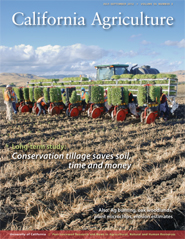All Issues

Long-term study: Conservation tillage saves soil, time and money
Cover:
Cotton production has traditionally relied on multiple tractor passes during the growing season, but targeted UC research — applying technological innovations — is demonstrating that conservation tillage is a viable option for California growers. In a 12-year study of cotton grown in rotation with tomato, conservation tillage lowered the number of tractor passes by about half, reducing labor and fuel usage. In the study’s later years, lint yields were equivalent in the standard and conservation tillage plots. This innovative tomato transplanter (cover) tills strips of a Hollister field, rather than the entire surface. Photo by Jeffrey P. Mitchell
July-September 2012
Volume 66, Number 3
Volume 66, Number 3





